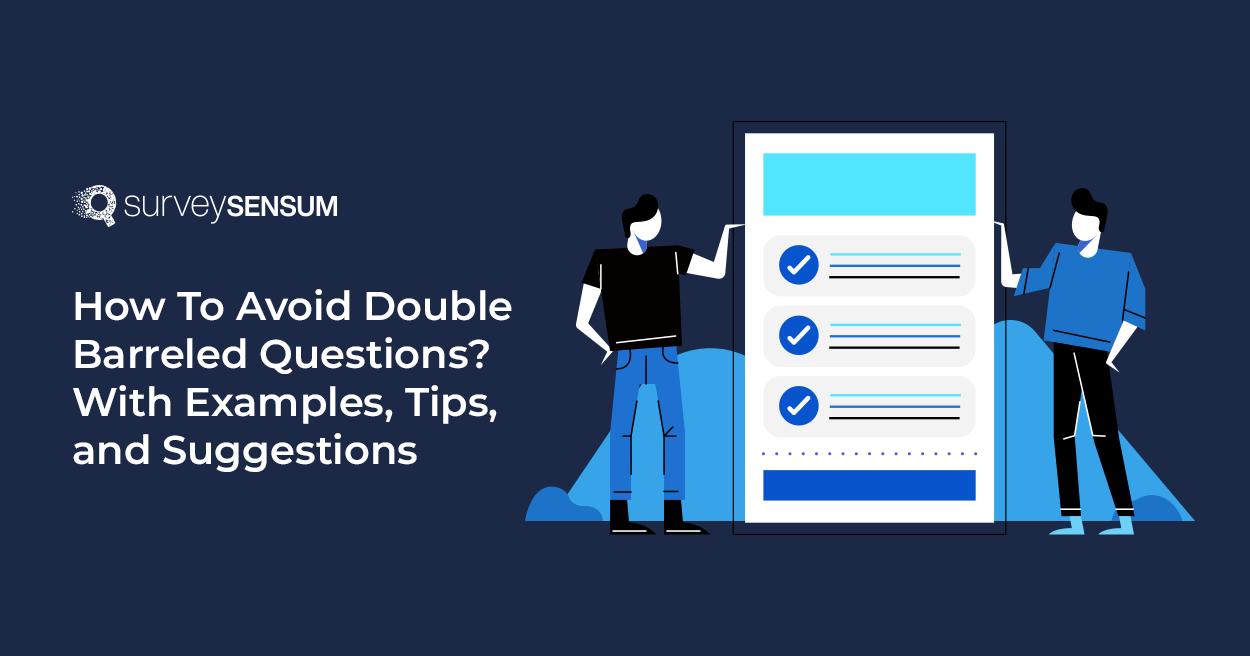
Ever stumbled upon a survey question that left you scratching your head, trying to figure out how to answer it accurately?
That’s likely a double barreled question, a sneaky trap that combines two distinct topics into one, making it a challenge for respondents to provide clear and reliable answers.
For example, take this question- “How satisfied are you with our website and delivery experience?”
What’s wrong with this question?
Well, this seemingly innocent question throws two unrelated aspects (website and delivery experience) into the same basket, expecting a single answer that will not do justice to your customer’s true feelings and experience about each aspect.
Well, let’s dive into the blog to know more about that.
This blog will also explore common survey errors to avoid, from leading questions that nudge respondents to loaded questions that assume too much. Plus, we’ll dish out practical tips to craft surveys that gather accurate data without leaving respondents scratching their heads – all with a robust survey builder.
Get ready to level up your survey game and gather insights that truly matter. Let’s dive in!
What Is a Double Barreled Question in a Survey?

A double barreled question in a survey is a single question that asks about two or more distinct issues or topics but only allows for one answer. This type of question can be confusing for respondents and lead to unreliable or inaccurate data because it assumes that both parts of the question will have the same response.
For example, “How satisfied are you with our customer service and product quality?” is a double barreled question because it combines two separate topics (customer service and product quality) into one question. A respondent might feel differently about each aspect but is forced to provide a single answer that doesn’t accurately reflect their views on both.
Why Should You Not Ask Double Barreled Questions in a Survey?
You should not ask double barreled questions in a survey for several reasons:
- Ambiguity in Responses: double barreled questions ask about two or more issues at once, making it unclear which issue the respondent is addressing. This ambiguity leads to data that is difficult to interpret accurately.
- Inaccurate Data: When respondents are forced to provide a single answer to a question that covers multiple topics, their response may not accurately reflect their opinions on all the topics. This results in unreliable data.
- Increased Cognitive Load: Ddouble barreled questions require respondents to consider multiple aspects simultaneously, increasing the cognitive effort needed to answer. This can lead to respondent fatigue and lower-quality responses.
- Reduced Respondent Satisfaction: Respondents may feel frustrated or confused by double barreled questions, which can lead to dissatisfaction with the survey process and a higher likelihood of incomplete or inaccurate answers.
- Difficulty in Analysis: Analyzing responses to double barreled questions is challenging because it’s not clear which part of the question the answer pertains to. This complicates data analysis and can lead to misleading conclusions.
- Bias and Misleading Results: double barreled questions can introduce bias, as respondents might feel pressured to give a positive or negative response to both parts of the question, even if they have differing opinions.
To ensure your survey data is accurate, reliable, and easy to analyze, it is essential to avoid double barreled questions and focus on asking clear, single-topic questions.
Create clear, focused questions with SurveySensum’s user-friendly survey builder to improve respondent understanding and gather accurate responses.
20 Examples of Double Barreled questions
Here are 20 examples of double barreled questions that combine two distinct topics into one, making it difficult for respondents to answer accurately:
- “How satisfied are you with our customer service and product quality?”
- “Do you find our website easy to navigate and visually appealing?”
- “How often do you exercise and eat healthy foods?”
- “Do you agree that our prices are fair and our products are high-quality?”
- “How do you rate our company’s communication and transparency?”
- “Do you support the new policy changes and the current management team?”
- “Are you satisfied with your job’s salary and benefits?”
- “How do you feel about the course content and the instructor’s teaching style?”
- “Do you believe our app is user-friendly and secure?”
- “How often do you attend our events and participate in our online forums?”
- “Are you happy with your work-life balance and career progression opportunities?”
- “Do you think our new product is innovative and affordable?”
- “How would you rate our customer support response time and resolution quality?”
- “Are you satisfied with the cleanliness and the overall atmosphere of our store?”
- “Do you agree that our company’s mission and values align with your own?”
- “How do you feel about the location and the amenities of your apartment?”
- “Do you find our newsletter informative and easy to read?”
- “Are you pleased with the speed and reliability of our internet service?”
- “How do you rate the taste and nutritional value of our food products?”
- “Do you think our training program is comprehensive and well-structured?”
Each of these questions combines multiple topics that should be addressed separately to obtain clear and actionable responses.
How to Avoid Asking Double Barreled Questions
To avoid asking double barreled questions in surveys, follow these guidelines:
1. Identify and Separate Issues: Review each question to ensure it addresses only one topic. If it covers multiple issues, split it into separate questions.
| Incorrect | Correct |
| “How satisfied are you with our customer service and product quality?” | “How satisfied are you with our product quality? |
2. Keep Questions Clear and Focused: Make sure each question is straightforward and targets a single aspect of the subject.
Example: Ask “How do you rate the quality of our product?” instead of combining it with another topic.
3. Use Simple and Direct Language: Avoid complex sentences that might combine multiple ideas. Stick to concise phrasing.
Example: Use “Was our customer support helpful?” rather than combining it with other attributes like speed or friendliness in the same question.
4. Pre-test Your Survey: Before finalizing, test your survey with a small group to identify any confusing or double-barreled questions. Revise based on their feedback.
5. Ask for Specific Feedback: When pre-testing, specifically ask participants if any questions seem to cover more than one topic. This can help you catch double-barreled questions you might have missed.
6. Review and Edit Thoroughly: Carefully review your survey multiple times to ensure clarity and focus on each question.
By following these steps, you can create clear, focused questions that gather accurate and reliable data from your respondents.
Don’t let double barreled questions derail your survey efforts. Switch to SurveySensum for seamless survey design!
Some Other Common Survey Errors to Avoid
When designing a survey, it’s important to avoid several common errors to ensure the data collected is accurate, reliable, and useful. Here are some common survey errors to avoid:
1. Leading Questions: These questions suggest a particular answer or influence the respondent’s response.
| Incorrect | Correct |
| “Don’t you think our product is great?” | “What do you think about our product?” |
2. Ambiguous Questions: Questions that are not clear or are open to multiple interpretations can confuse respondents.
| Incorrect | Correct |
| “Don’t you think our product is great?” | “What do you think about our product?” |
3. Loaded Questions: These questions contain assumptions that may not be true for all respondents.
Example: “How much do you enjoy our excellent customer service?” assumes the service is excellent for everyone.
Complex Language: Using jargon, technical terms, or complex language can confuse respondents, especially if they are not familiar with the terminology.
| Incorrect | Correct |
| “Don’t you think our product is great?” | “What do you think about our product?” |
5. Double-Negative Questions: Questions that use double negatives can be confusing and hard to interpret.
| Incorrect | Correct |
| “Don’t you think our product is great?” | “What do you think about our product?” |
6. Overlapping Answer Choices: Ensure that answer choices are mutually exclusive to avoid confusion and overlapping responses.
Example: For age ranges, avoid “20-30” and “30-40” and instead use “20-29” and “30-39”.
7. Not Providing a “Don’t Know” or “Not Applicable” Option: For some questions, respondents may not have an opinion or the question may not apply to them.
Example: Include an option like “Not Applicable” for questions that might not be relevant to all respondents.
8. Unbalanced Answer Scales: Ensure that scales are balanced and provide equal weight to all potential responses.
Example: A satisfaction scale should range evenly from “Very Unsatisfied” to “Very Satisfied” without biasing toward positive or negative responses.
9. Too Many Open-Ended Questions: While open-ended questions can provide valuable insights, too many of them can be time-consuming and may lead to lower completion rates.
Example: Balance the survey with both open-ended and closed-ended questions to gather detailed and quantitative data.
10. Survey Length: Surveys that are too long can lead to respondent fatigue, resulting in lower completion rates and less accurate responses.
Example: Keep the survey concise and focused on the most important questions to maintain respondent engagement.
By avoiding these common survey errors, you can improve the quality of your survey data and ensure more accurate, reliable, and actionable insights.
Conclusion
In conclusion, understanding and avoiding double barreled questions in surveys is crucial for obtaining accurate and reliable data. By using clear, single-topic questions and following best practices, such as those outlined in this discussion, survey designers can improve the quality of their surveys and the insights gained from them.
To achieve this, all you need is a robust tool like SurveySensum at your disposal. Surveysensum, with its focus on effective survey design and analysis, can be a valuable tool in this process, helping researchers and organizations gather actionable information from their surveys.
Revolutionize your survey game with SurveySensum. Start creating surveys that drive actionable insights!
FAQs on Double Barreled Questions
A double barreled survey question combines two distinct questions into one, making it difficult for respondents to answer accurately. Example of double barreled question: “Do you think the company’s new policy is fair and effective?” This question should be split into two separate questions about fairness and effectiveness.
A double leading question combines two elements that both guide the respondent toward a particular answer. For example, “Don’t you agree that our new product is both innovative and affordable?” This question implies a positive response about both innovation and affordability.
The double barreled survey question fallacy occurs when a question is flawed by asking about two or more issues at once, leading to ambiguous or unreliable answers. This fallacy results in data that can’t clearly separate the respondent’s opinions on the distinct issues being asked.
A double-barreled hypothesis combines two or more variables into a single statement, making it unclear which variable is responsible for the outcome. For example, “Increased study time and participation in study groups lead to better academic performance.” This hypothesis should be split to examine the effects of study time and study groups separately.
A double-barreled question is one that asks about two different things in a single question, making it difficult for respondents to answer accurately. A double barreled question example:
“How satisfied are you with our customer service and product quality?”
This question combines two separate issues (customer service and product quality) into one, which can lead to confusion and unclear responses.















